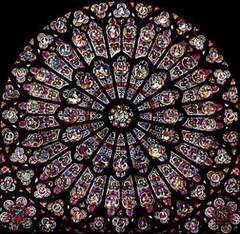 Rose Window, Notre Dame Cathedral
Rose Window, Notre Dame Cathedral "To some, art is freedom of expression of all kinds, and its means and objectives are myriad.
To my friend Richard Wayne Mullins, art had a specific purpose. He never questioned whether art was meant to communicate; hypothetical discussions of the merit of non-communicative schools of art made him chuckle. Which communicated pretty clearly what he thought.
Richard's art communicated, and not subtly. He wanted it to; he insisted that it do so. He honed and tinkered and shaped songs into sculptor's tools. He preferred to baptize those songs with the tears of their first hearers before he took them on the road. Until they took on life of their own and began to move audiences, his ideas for songs were carefully put up with the dozens of others which still revolved through his mind in a fluid state of progress.
To find the source of the artist's technique, we ponder what is in his heart. Out of a man's heart, the mouth speaks; or, in Richard's case, sings.
Richard's heart was full of longing, and even in the mid- to late- seventies, his mind was fully furnished with the world of twelfth-century thought seen through the eyes of saints and sinners. How did he discover a way to touch his modern audience--convey his heart full of sunlight and shadow--through the stained glass prism of eight-century old conventions?
It helped that Richard was thoroughly fascinated with people. He studied them as a painter studies the juxtaposition of color, probably studied them harder than the textbooks at Bible College during the years I knew him. He found equal fascination with historic people as living ones. In studying people, he found the same constants of the human condition as King David had millennia before: downcast or darkened aspects of the wounded soul in a world of imperfection, a separation from God, a need to love, a longing for love, redemption, a reunion with God, praise for perfection found in God. These responses describe a cycle of transformation we all may travel through many times in a lifetime, or during a personal crisis, many times in a single day.
Rich Mullins cited Scriptures extensively in his liner notes, but rarely lifted the language of Scripture for his songs. He knew and respected the power of that language, but he knew that even more than making pretty or powerful or scriptural Christian songs, he needed to experience Christ in his life. He strove to convey Christ in his songs to precisely the degree he experienced Jesus in his life. By remaining true to his experiences, Richard blessed his audience with permission to struggle through the process of living out their faith--just as he did. "
--Pam Richards, from the work in progress Let the Mountains Sing
"Someday I shall be a great saint - like those you see in the windows of magnificent cathedrals. I will have a soul made of sunlight and skin as clear as the stained glass panels that make their skin, and I will shine like they do now - I will shine with the glory that comes over those who rise up early and seek the Lord. . . "
". . . But I do not shine so now - especially not in the morning. In fact, I grimace until noon, I would never be mistaken for a stained glass saint, though at 7 AM I might be grey and grotesque as a gargoyle. By faith I accept that 'God's commands are not burdensome,' but right now, I am not grown in that measure of grace that frees me to exalt in this particular command to seek Him 'early in the morning.'" -- Richard Mullins
This is the ninth in a series about the upcoming book, Let the Mountains Sing. The beginning post is here.

 RSS Feed
RSS Feed